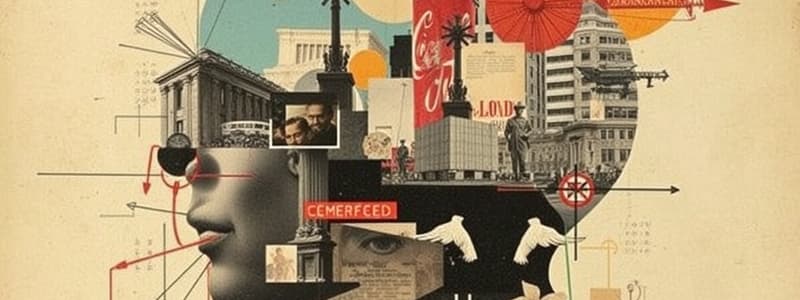Podcast
Questions and Answers
What is art?
What is art?
- Music (correct)
- Visual arts (correct)
- Literature (correct)
- Theater (correct)
What is a work of art?
What is a work of art?
The visual expression of an idea or experience, formed with skill, through the use of a medium.
What is a medium in art?
What is a medium in art?
A particular material along with its accompanying technique chosen by the artist.
What describes mixed media art?
What describes mixed media art?
What is creativity?
What is creativity?
What are the five traits that define creativity?
What are the five traits that define creativity?
What is photomontage?
What is photomontage?
What are folk artists?
What are folk artists?
What is representational art?
What is representational art?
Define abstract art.
Define abstract art.
What is the difference between 'looking' and 'seeing'?
What is the difference between 'looking' and 'seeing'?
What is depicted in Georgia O'Keeffe's 'Jack-in-the-Pulpit No. V'?
What is depicted in Georgia O'Keeffe's 'Jack-in-the-Pulpit No. V'?
Flashcards are hidden until you start studying
Study Notes
Understanding Art
- Art encompasses various forms such as music, theater, literature, and visual arts (drawing, painting, sculpture, film, architecture, and design).
- It communicates meanings that extend beyond verbal language.
Work of Art
- Defined as the visual expression of an idea or experience formed skillfully through a chosen medium.
Medium
- Refers to the specific material and technique employed by an artist.
- Influences the artwork's function; can be traditional or modern.
Mixed Media
- Artwork created using a combination of different materials.
Creativity Defined
- The ability to produce something new that holds value and relevance, influencing future thought or action.
- Creativity is not merely novelty; it has the power to shape perspectives.
Five Traits of Creativity
- Associating
- Questioning
- Observing
- Networking
- Experimenting
Key Artist: Janet Echelman
- Created "Her Secret Is Patience" (2009): a 100' tall public artwork in Phoenix, Arizona, made of fiber, steel, and lightning.
- Inspired by natural forms, particularly cactus, emphasizing the collaborative nature of art.
Photomontage
- A composite image made from various photographs, illustrating how visual elements can be blended.
Example: Robin Rhode's "He Got Game"
- A series of twelve color photographs mimicking slow-motion basketball moves through chalk drawings, representing playfulness and interaction with form.
Romare Bearden's Works
- "Prevalence of Ritual: Tidings" (1967): Uses photomontage to express musicality and memory tied to African-American identity.
- "Rocket to the Moon" (1971): Another collage reflecting similar themes using vivid imagery.
Artist Types
- Trained Artists: Acquired skills through formal education or apprenticeships.
- Untrained Artists: Include children, naïve artists, and folk artists who express creativity without formal training.
Notable Folk Artist: Sabatino "Simon" Rodia
- Creator of "Nuestro Pueblo" (1921-1954), using discarded materials to build towers in Watts, California, without the use of power tools.
Retablo in Art
- A traditional Mexican and Southwestern art form depicted in painted tin, often expressing gratitude.
Representational vs. Abstract Art
- Representational Art: Depicts real objects and figures, often aiming for realistic appearance (e.g., William Harnett's trompe l'oeil).
- Abstract Art: Lacks references to natural objects and may involve simplifications or distortions (e.g., Theo van Doesburg's works).
Nonrepresentational Art
- Visual forms with no specific external references, similar to pure musical sounds (e.g., Alma Woodsey Thomas’s "Gray Night Phenomenon").
Observation and Interpretation
- "Looking" involves a mechanical engagement, while "Seeing" signifies a deeper, emotional connection, enhancing appreciation of art’s form and content.
Iconography
- The use of symbols and motifs to convey deeper meanings within artworks (e.g., Christian themes in various religious images).
- Involves understanding of cultural and historical context behind visual representations (e.g., Amida Buddha's physical traits symbolizing enlightenment).
Contrast in Artistic Intent
- Rodin's "The Kiss" (1886) focuses on a passionate representation, while Brancusi’s "The Kiss" (1916) reduces form to a symbolic expression of unity.
Importance of Context in Art
- Understanding iconography helps decode the visual messages and emotional layers in art, linking viewer interpretation to broader cultural narratives.
Studying That Suits You
Use AI to generate personalized quizzes and flashcards to suit your learning preferences.


